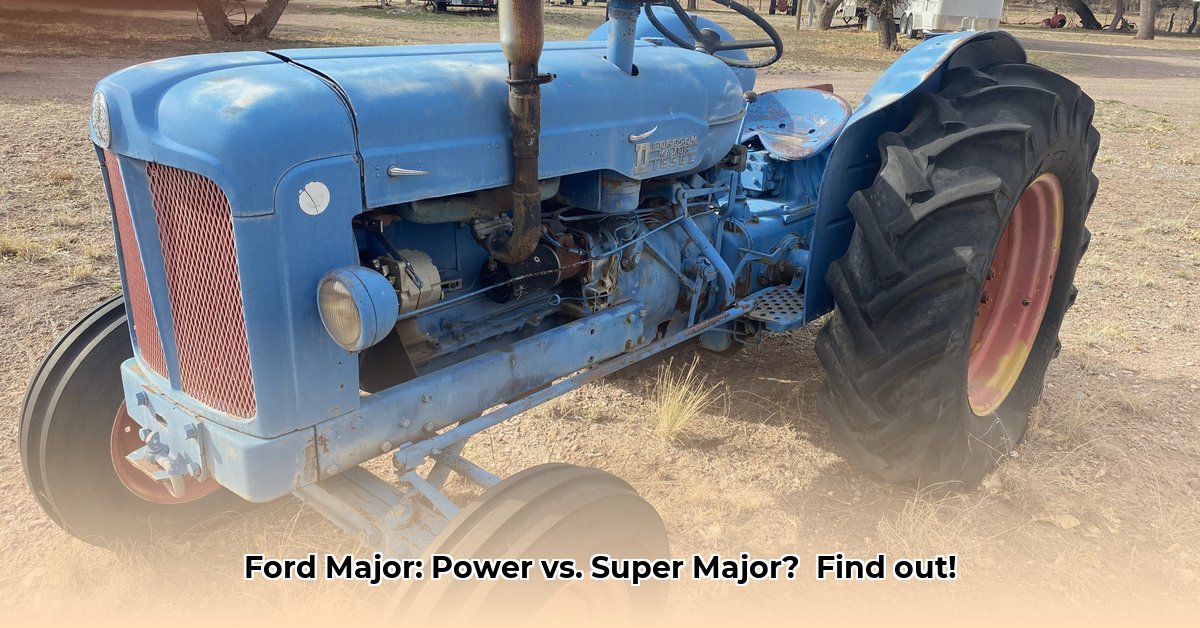
Under the Hood: Engine and Power Differences
The Fordson Power Major and Super Major tractors, produced between 1958 and 1964, both utilized dependable four-cylinder engines available in gasoline or diesel configurations. While both boasted approximately 47 horsepower, subtle differences existed. The Super Major, introduced in 1961, offered a slightly increased power output, though precise figures are difficult to confirm. More significantly, the Super Major featured a larger 20-gallon fuel tank compared to the Power Major's 17.4-gallon tank, translating to less downtime for refueling and increased operational efficiency. This seemingly small difference impacted the workday significantly, especially during demanding harvest seasons. Did this extra fuel capacity significantly impact daily workload? Real-world experiences suggest it did. For more detailed specifications, see this helpful resource.
Hydraulics and Performance: A Technological Leap
The hydraulic systems represent a key differentiating factor between the two models. The Power Major employed a gear pump system, known for its reliability but lacking the smoothness and responsiveness of later designs. The Super Major, however, incorporated an open-center hydraulic system, providing a much smoother and more efficient operation, similar to the difference between a manual and an automatic transmission in a car. This upgrade significantly enhanced operator comfort and overall efficiency. Furthermore, the Super Major boasted a slightly higher hydraulic pump flow rate of 6 gallons per minute (gpm), compared to 5.65 gpm for the Power Major, contributing to faster work in the field. Farmer testimonials consistently highlight this improvement in operational speed.
Transmission and Operation: A Skillful Touch
Both tractors featured unsynchronized transmissions, requiring skilled clutch operation during gear changes – a common characteristic of tractors from that era. The open operator station, while providing excellent visibility, exposed the operator to the elements. This design choice reflects the robust build and straightforward functionality of these workhorses.
Design and Aesthetics: Subtle but Noticeable Differences
Although sharing a similar overall chassis design, subtle visual differences distinguish the two models. Tire size variations are one key example. The Power Major used 6.00-19 front and 11-36 rear tires, while the Super Major sported 6.00-16 front and 12.4-38 rear tires. These variations likely reflect adjustments to accommodate diverse soil conditions and implement types.
A Comparative Overview: Power Major vs Super Major
| Feature | Fordson Power Major | Fordson Super Major |
|---|---|---|
| Production Years | 1958-1961 | 1961-1964 |
| Engine Type | 4-cylinder, Gas/Diesel | 4-cylinder, Gas/Diesel |
| PTO Horsepower | ~47 hp (approx.) | ~47 hp (approx.) |
| Fuel Tank Capacity | 17.4 gallons | 20 gallons |
| Hydraulic System | Gear Pump | Open Center |
| Hydraulic Flow | 5.65 gpm | 6 gpm |
| Front Tires | 6.00-19 | 6.00-16 |
| Rear Tires | 11-36 | 12.4-38 |
The Verdict: Choosing Your Workhorse
The ideal choice between the Power Major and Super Major depends on individual needs and preferences. Both represent robust machines reflecting the agricultural landscape of the mid-20th century. The Super Major, with its improved hydraulics and increased fuel capacity, offers undeniable advancements. However, operation of both models demanded and rewarded skilled mechanical understanding from its operators. Each tractor played a critical role in shaping farming practices of its time.
Fordson Power Major vs Super Major: Hydraulic System Deep Dive
The significant difference between the Fordson Power Major and Super Major lies in their hydraulic systems, reflecting a technological advancement in precision farming. While detailed specifications on the Power Major's hydraulics are limited, the Super Major's system stands out.
Engine Power and Delivery: A Notable Improvement
Both tractors utilized similar 3.6-liter four-cylinder diesel engines. However, the Super Major benefited from upgrades, including a refined Minimec injector pump, modified engine block, and a new "FL" cylinder head. This resulted in a considerable power increase to 69 KM (51.5 kW), showcasing a significant advancement over its predecessor. While precise horsepower figures for the Power Major remain unavailable, it is clear that the Super Major provided a substantial performance boost.
Hydraulic Systems: Precision Farming Revolution
The Super Major's hydraulic system marked a substantial step forward. While the Power Major's system lacked detailed documentation, the Super Major featured position control, a double-acting top link draft control, and a drop control valve. These features drastically improved precision in tasks like plowing and cultivating, enhancing versatility and efficiency. This upgrade likely resulted in substantial time savings and reduced operator fatigue.
Maintenance and Parts Considerations
Maintaining both tractors requires diligent attention to fluid changes, hose and seal inspections, and leak detection. Sourcing parts for these vintage machines may require additional effort, making establishing a relationship with a specialized parts supplier highly recommended. Preventative maintenance is key to extending their lifespan and mitigating costly repairs.
Key Differences Summarized:
- The Super Major significantly surpasses the Power Major in power output.
- The Super Major’s refined hydraulic system offers superior precision and control.
- Maintenance for both requires detailed attention and often entails obtaining specialized parts.
- Data limitations present challenges in creating a perfectly comprehensive comparison.